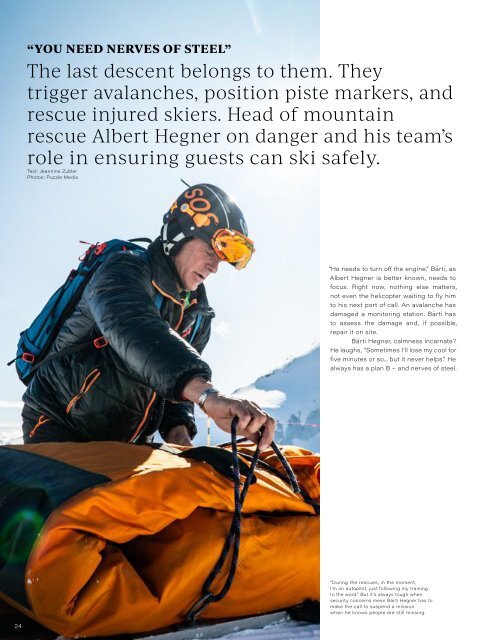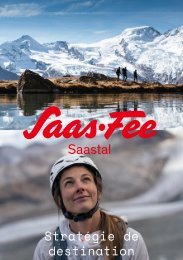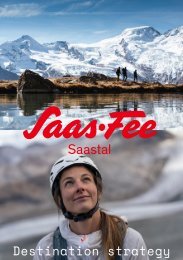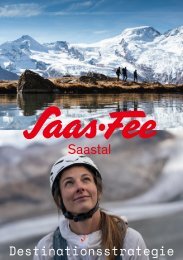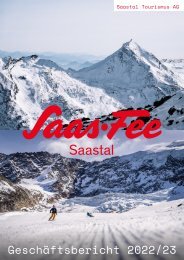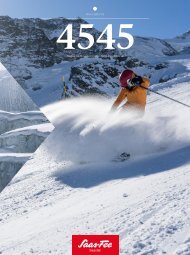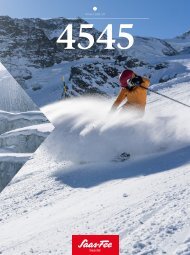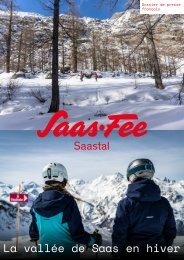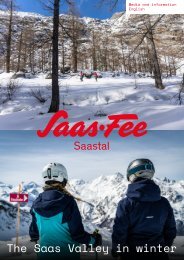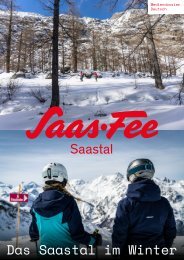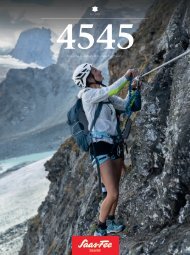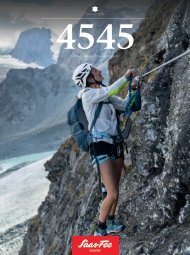Create successful ePaper yourself
Turn your PDF publications into a flip-book with our unique Google optimized e-Paper software.
“YOU NEED NERVES OF STEEL”<br />
The last descent belongs to them. They<br />
trigger avalanches, position piste markers, and<br />
rescue injured skiers. Head of mountain<br />
rescue Albert Hegner on danger and his team’s<br />
role in ensuring guests can ski safely.<br />
Text: Jeannine Zubler<br />
Photos: Puzzle Media<br />
“He needs to turn off the engine.” Bärti, as<br />
Albert Hegner is better known, needs to<br />
focus. Right now, nothing else matters,<br />
not even the helicopter waiting to fly him<br />
to his next port of call. An avalanche has<br />
damaged a monitoring station. Bärti has<br />
to assess the damage and, if possible,<br />
repair it on site.<br />
Bärti Hegner, calmness incarnate?<br />
He laughs, “Sometimes I’ll lose my cool for<br />
five minutes or so... but it never helps.” He<br />
always has a plan B – and nerves of steel.<br />
“I always have a plan B”<br />
The ability to stay calm is indispensable in a job where the situation is<br />
constantly changing. And ‘routine’ is an alien concept to Bärti. The one<br />
fixed point in his schedule is at half-past four each morning when he<br />
is always in his office at the valley station. From there, he analyzes the<br />
previous night, and in particular the information collected by his snowcat<br />
drivers. He uses everything at his disposal to estimate the current<br />
avalanche risk and decides whether the ski area will open that day.<br />
The Swiss Avalanche Institute (SLF) makes a general<br />
recommendation for the area which serves as a guide. In addition to<br />
all of that, he sometimes draws on the experiences of his predecessor<br />
Dominik Kalbermatten, who boasts 25 years worth of valuable<br />
knowledge when it comes to assessing the snow situation in the<br />
area. Sometimes, Bärti has to increase the danger level above the<br />
SLF recommendation. As the head of mountain rescue for the high<br />
alpine ski resort Saas-Fee, he has a huge responsibility and faces<br />
several challenging decisions daily. A particular challenge of this ski<br />
resort is that it starts at an altitude where many others end, at 1,800<br />
metres above sea level. The avalanche situation is rarely clear cut.<br />
As the leader of the mountain rescue team, he is responsible for the<br />
safety of the whole area. It would even be his duty to recommend total<br />
evacuation if the avalanche risk were to reach levels that extreme.<br />
He makes these decisions with the support of the Bergbahnen (lift<br />
company) management team as well as the crisis staff at the town hall.<br />
After a heavy snowfall, the ski resort usually stays closed at<br />
the beginning of the day. It remains closed until Bärti and his team<br />
can detonate explosives to trigger controlled avalanches in highrisk<br />
areas, removing dangerous buildups of snow from the steepest<br />
slopes. They usually use a helicopter, or, when there is no other<br />
option, they ski tour and do the job by hand. When it comes to touring,<br />
Bärti needs to carry around 20 kilograms of explosives in his backpack.<br />
Is that not scary? “It‘s heavy,” he says with a wink. Once the<br />
snow loads on the steep slopes have been reduced, the avalanche<br />
Both in Saas-Fee and Saas-Grund there<br />
are glacier slopes. Leaving the pistes<br />
in glacial areas is extremely risky and<br />
re-quires years of experience, training,<br />
and knowledge of crevasse rescue and<br />
how to use ropes effectively. Mountain<br />
guides know the area well and offer ski<br />
and snowboard freeride tours.<br />
Saas-Fee‘s piste patrol works closely with Air Zermatt. For complex rescues in<br />
difficult-to-access terrain, Bärti calls in the helicopter. This is often the case when the<br />
rescue requires heavy equipment.<br />
situation can be reassessed. And when it reaches a reasonable level<br />
of risk, they can reopen the snowsports area. That doesn’t mean the<br />
risk has totally resolved, Bärti emphasises: “You should never lose<br />
your respect for the mountains. Avalanche danger prevails, as long<br />
as there is snow on the ground.”<br />
Crevasses also present a huge risk factor. In the winter they<br />
lie hidden under a sheet of snow. Even Bärti, who knows the area<br />
and its terrain better than most, says that leaving the marked pistes<br />
on the glacier is too dangerous for him. He has witnessed far too<br />
many rescue missions for that. He recalls the time a young snowboarder<br />
fell into a crack below the Allalinhorn. Despite the efficient<br />
rescue effort, the snowboarder later died in the hospital. Such cases<br />
can really affect Bärti and the team. Especially when children are<br />
involved, he reflects, becoming more pensive. “During the rescues, in<br />
“During the rescues, in the moment,<br />
I’m on autopilot, just following my training<br />
to the word.” But it‘s always tough when<br />
security concerns mean Bärti Hegner has to<br />
make the call to suspend a mission<br />
when he knows people are still missing.<br />
saas-fee.ch/bergfuehrer<br />
Avalanche bulletin<br />
Produced by the WSL Institute for Snow<br />
and Avalanche Research SLF, the<br />
bulletin appears twice daily in winter: find<br />
it on slf.ch or the app for smartphones.<br />
“We talk a lot within the team about<br />
the things we experience. Talk,<br />
talk, and talk again, it helps us to<br />
process everything.”<br />
24<br />
25


